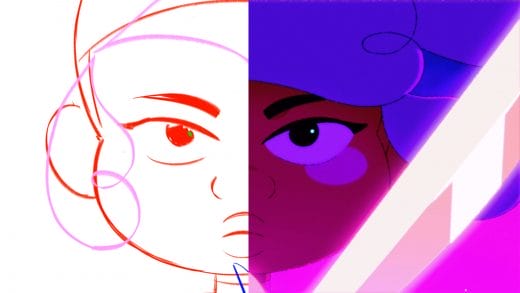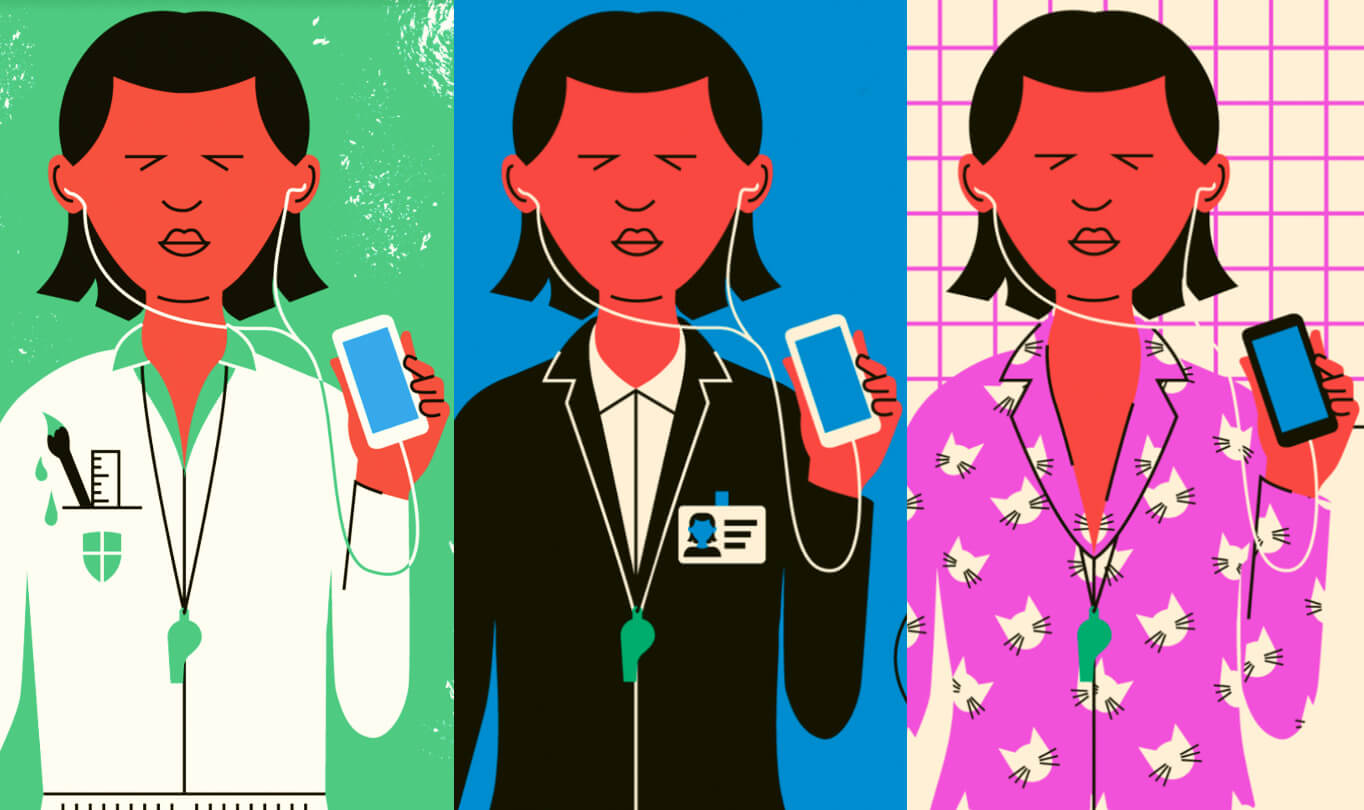

Women today make up the majority of the American workforce, which has resulted in a notable shift away from the tradition of single income families with a stay at home mom. But working mothers face serious challenges in finding balance between parenting and their careers. Now, the most pressing challenge is the pandemic.
Studies show that in families with two working parents, women continue to take on more of their household’s responsibilities. This reality has been exacerbated by the pandemic, which brought the closure of daycares and schools. In recent decades, early childhood education has encouraged women’s participation in the workplace by providing options for daytime childcare.
However, the loss of this support system during this pandemic has been a major setback for working mothers, potentially undoing 10 years of progress in workplace gender equality. In the animation industry, in which only 20% of creatives are women, the impact of the pandemic has certainly been felt. To understand how mothers in animation have handled the challenges of lockdowns, we spoke with some of these women.
Beth Sleven is a busy supervising director and a mom of two, ages 3 and 6. Her husband is a stay at home dad, which has allowed Beth to focus on her career full time. “I have always been adamant about keeping my work life and home life separate. But in switching to remote work, that separation has become nearly impossible,” she says.
Beth explains that the collapse of the separation between work and life has been a difficult adjustment, but that she’s grateful for one particular aspect of it. “I don’t have a commute anymore, and there are no longer networking events to attend. Having that time back means I can have lunch with my family every day, and I have more time to spend with my kids after work. I’ve had time to really hang out with my kids, and that’s been special.”
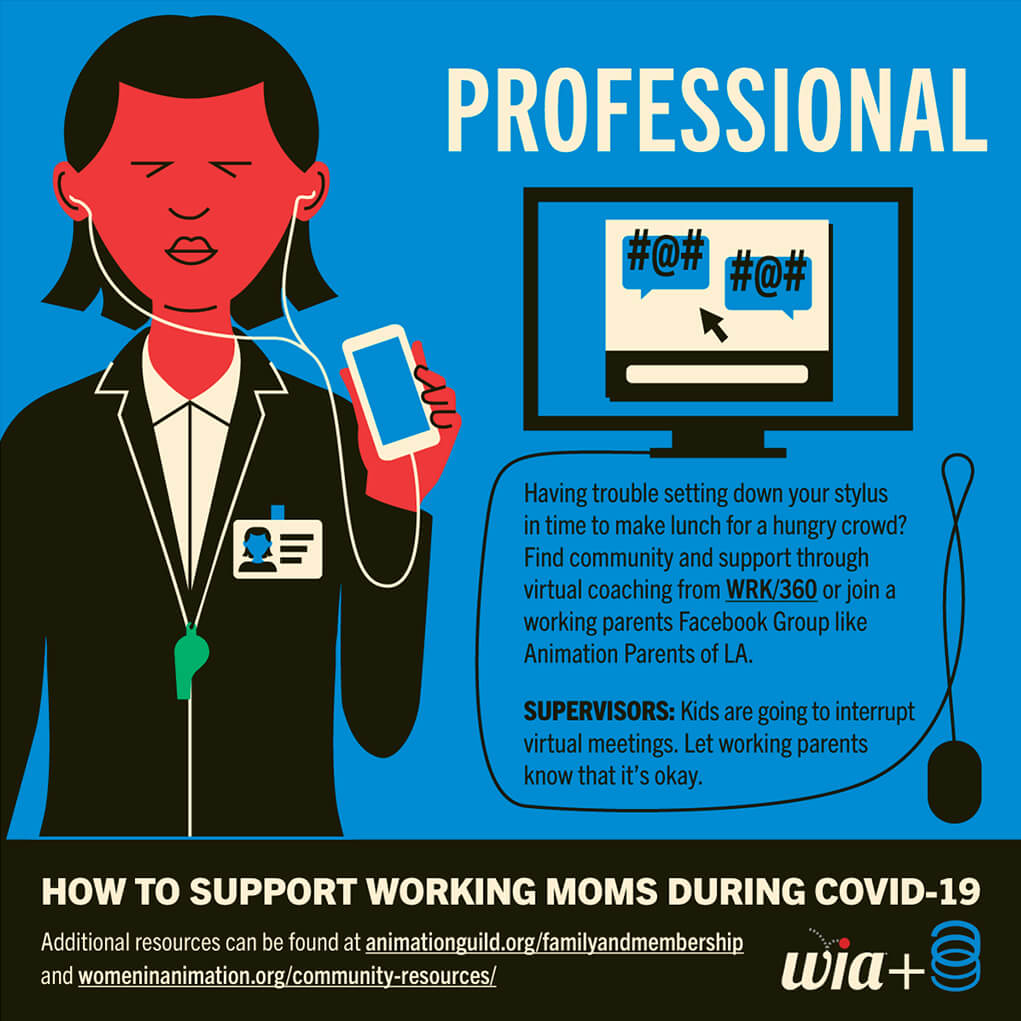
Beth shared with us that in the past, she has felt the classic working parent guilt of feeling like she doesn’t have enough time to spend with her kids. Before lockdown, long and hectic work days, traffic jammed commutes, and networking events made it difficult to fit in quality time with her children.
Research shows that this feeling is common amongst parents, with 20% of working mothers reporting that they find balancing work and family very difficult. For Beth, the silver lining is that her husband is a stay at home dad. “We know that for many families this isn’t an option, so we feel so very fortunate and privileged to be able to do this as long as we can,” she says.
For two-parent families in which both are working full-time, remote work and remote learning has required complex solutions. Megan Kreiner is an animator at Walt Animation Disney Studios. She and her husband, who also works full-time, share parenting responsibilities for their two children, ages 7 and 10. Even before the pandemic, Megan says balancing motherhood and work was tough. “There’s definitely a misnomer about the possibility of balancing both a career and parenting,” Megan tells us. “In my experience, something’s always gotta give. Having a career and children together requires a lot of sacrifice, especially when both parents are working full time.”
Megan says that when the pandemic lockdowns started, she and her husband quickly realized that it would be tremendously difficult to keep up with their work while also juggling remote learning for their kids. For them, the solution was to hire daytime help. Their family’s caregiver comes to their home during school hours to provide an extra hand in keeping the kids on task so Megan and her husband can focus on their jobs.
“I’m still involved with supporting the kids during remote learning, so it can be very difficult to stay focused on creative tasks for work,” Megan says, “without help it’s unlikely that I would be able to work full-time.” Hiring a private caretaker has been immensely helpful for Megan’s family, but this may not be a solution that is accessible to all workers.
The experience of women in the workforce can vary depending on the ages of their children, too. Jeanette Moreno King is an animation director, President of The Animation Guild, and mom of two children, ages 11 and 14. She says that her kids are old enough that they can be mostly independent throughout the day as they attend their virtual classes.
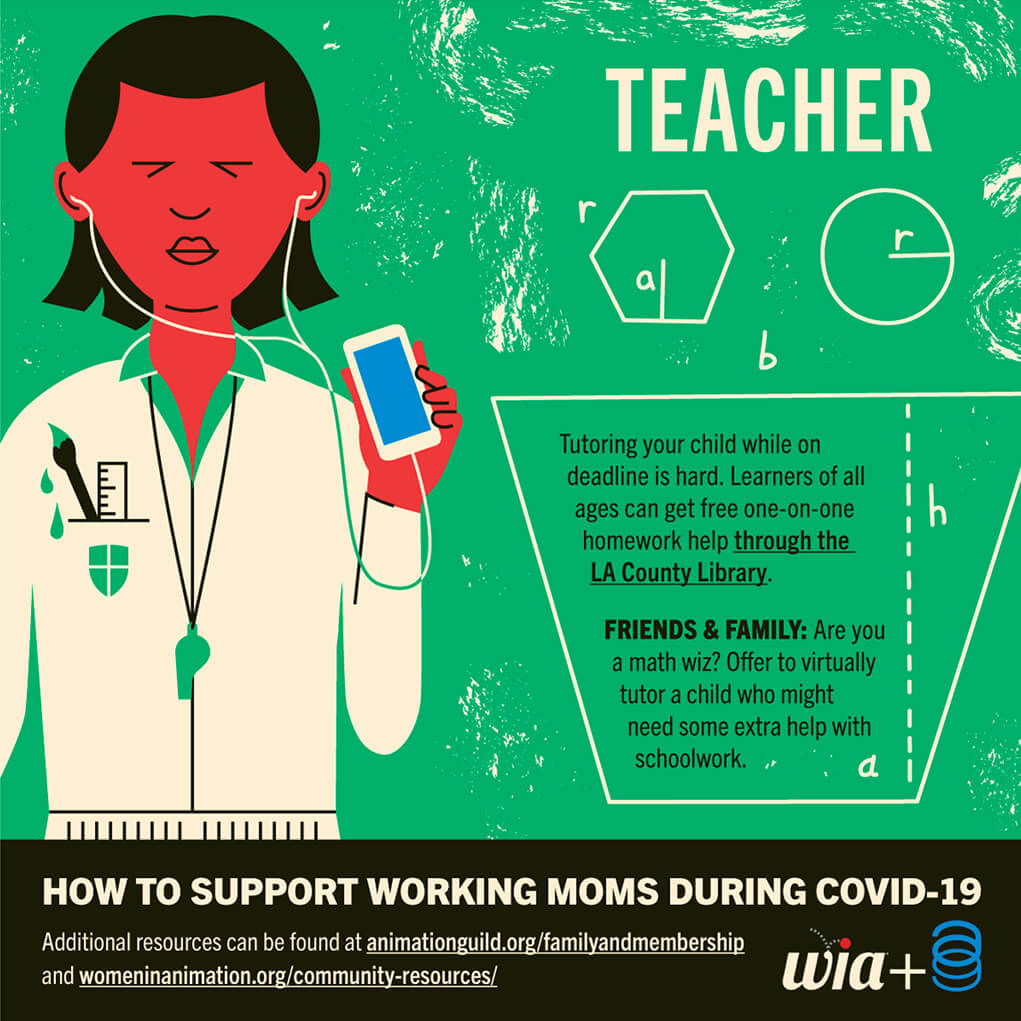
Jeanette explains that it’s difficult to cope with the emotional toll of the pandemic. “It’s been hard to keep my kid’s morale up, and to keep them motivated,” she says. “They’re used to having a social component in school, and they’re missing milestones that are so important at that age.” Jeannette tells us it’s a struggle to assure her children that things will get better, because they are old enough to fully comprehend the impact of the pandemic. “As a parent,” Jeanette says, “you want to make everything better for your kids, and when you can’t do that, it’s painful.”
Having been in the industry for over two decades, Jeanette is well aware of the varying obstacles that mothers in animation face. She says that when she started out in animation, parenting wasn’t talked about at work. “When I first got pregnant, I felt like I needed to learn the secret parenting handshake to connect with other parents. Everyone was so quiet about their family lives.” But over the years, she’s seen this change.
Jeanette says that with every new generation that enters the animation field, the traditional workplace norms shift. “I’ve noticed that younger generations of parents are much more open and honest about their difficulties in balancing work and family. There used to be a martyrdom attitude to work in this industry, but it’s fading. Instead, we’re having more conversations about how the animation field can support not just mothers, but all parents.”
According to Jeanette, this shift is reflected in The Animation Guild as well. The Guild is a labor organization that represents animation and visual effects artists. Historically, unions have focused on traditional work issues like safety on the job, wages, and healthcare benefits. In recent years, Jeanette says the Guild has recognized the importance of offering support beyond those traditional issues. “We’re realizing that the Guild can be a hub of communication that supports people with all types of workplace related issues, including ones having to do with parenthood,” she says.
One initiative in support of this shift has been the creation of a Discord channel for Guild members. Discord is an instant messaging and digital distribution platform designed for creating communities. On the Guild Discord, members can discuss anything and everything. “It’s an accessible space for members to connect with each other, share their experiences, and offer advice and encouragement to each other,” says Jeanette. She explains that initiatives like this are changing the way people communicate in the workplace by normalizing vulnerability. When Jeanette started her career, she felt that she couldn’t ever show vulnerability.
“If I did, people might attribute it to me being a woman. I’m happy to see that changing.”
Jeanette Moreno King on normalizing vulnerability
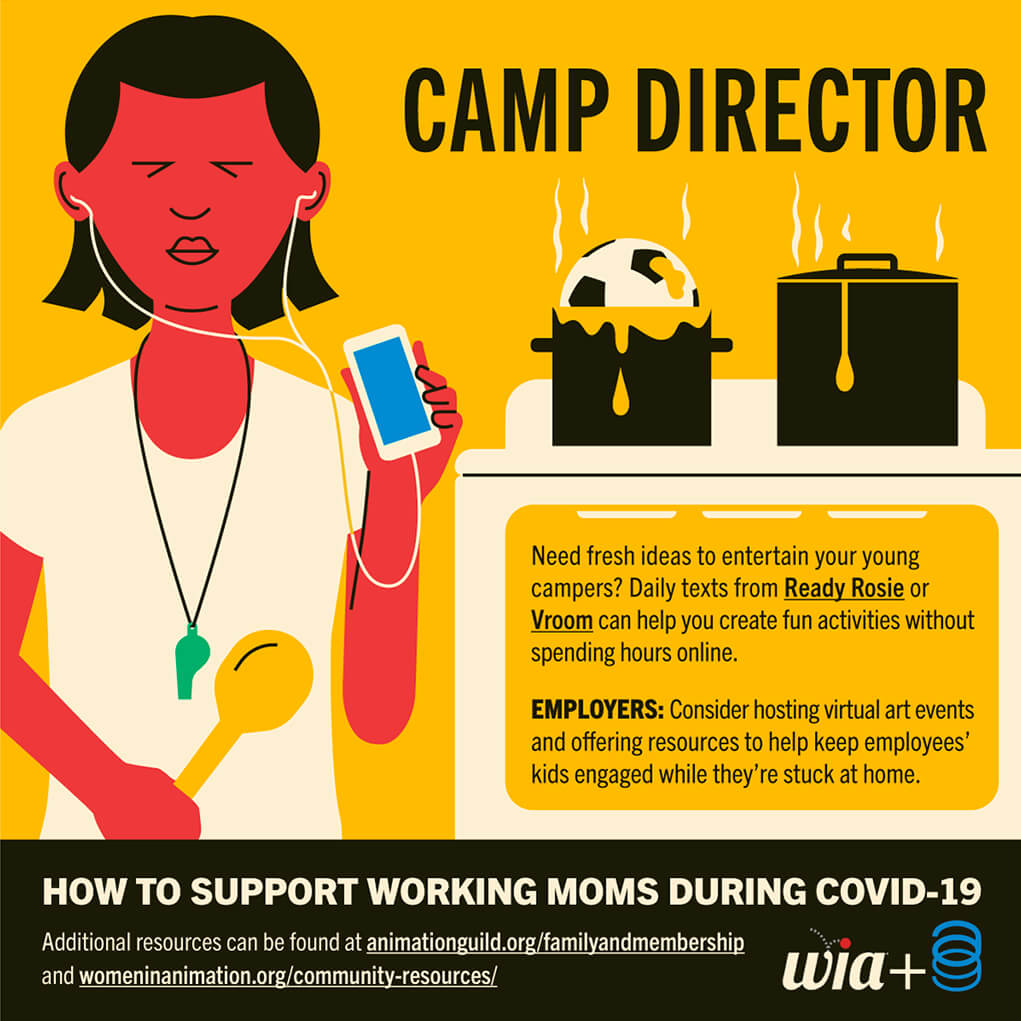
Another Animation Guild initiative that is encouraging new approaches to workplace support is the Family and Membership Committee (FAM Committee). Kristin Donner, Chair of the committee, tells us that her team quickly realized there wouldn’t be a one size fits all solution for the challenges that the committee’s members were facing with remote work.
Kristin says that this is because every member’s needs are unique. For example, the parents of an infant need a different kind of support than the parents of teenagers. “Moreover,” Kristin says, “obstacles aren’t always directly related to parenting. Since the start of the pandemic, the FAM committee has put extra emphasis on the importance of wellness and mental health. We’ve created a safe space for members to share their stories and experiences.”
Although the committee is known as the “family” committee, it isn’t exclusively for parents. According to Kristin, the committee exists to provide a supportive community for members in any stage of life. “We feel that it’s important to acknowledge diverse forms of family and different dynamics of caregiving. Some of our members may not be parents, but they may be caring for an elderly loved one, or supporting a sick partner or friend. Regardless of how you define your family, or what kind responsibilities you have in your personal life, you can find support in the FAM committee.”
Kristin says that she believes the work from home conditions spurred by the current pandemic might result in positive changes that stick around post pandemic. And the other women we spoke with think so too. When animation teams begin returning to working in the studio, Megan Kreiner hopes that flexibility is maintained, as well as broader conversations about the perceptions around parenting and family support. “In my experience,” she says, “there’s a perception that parents are less dedicated to their work. We need to continue to challenge this perception, because it’s not true.”
Across sectors, these perceptions can perpetuate the motherhood gap, also known as the motherhood penalty. When men and women first enter the workforce, they’re typically paid equally. But a pay gap begins to appear when women get married and have children. While some women choose to work less once they have children, many don’t. Regardless, research shows employers pay them less because they seemingly assume mothers will be less committed to their work. This might further explain why in the animation industry, only 10% of leadership roles are held by women.
The initiatives of the Animation Guild and the FAM Committee show that it is gradually becoming normalized to have open conversations about the challenges of balancing work and life. This signals a changing approach to workplace culture within the animation industry. By listening to the diverse experiences of women, parents, and caregivers in animation, we can begin to lay the groundwork for tangible change.




